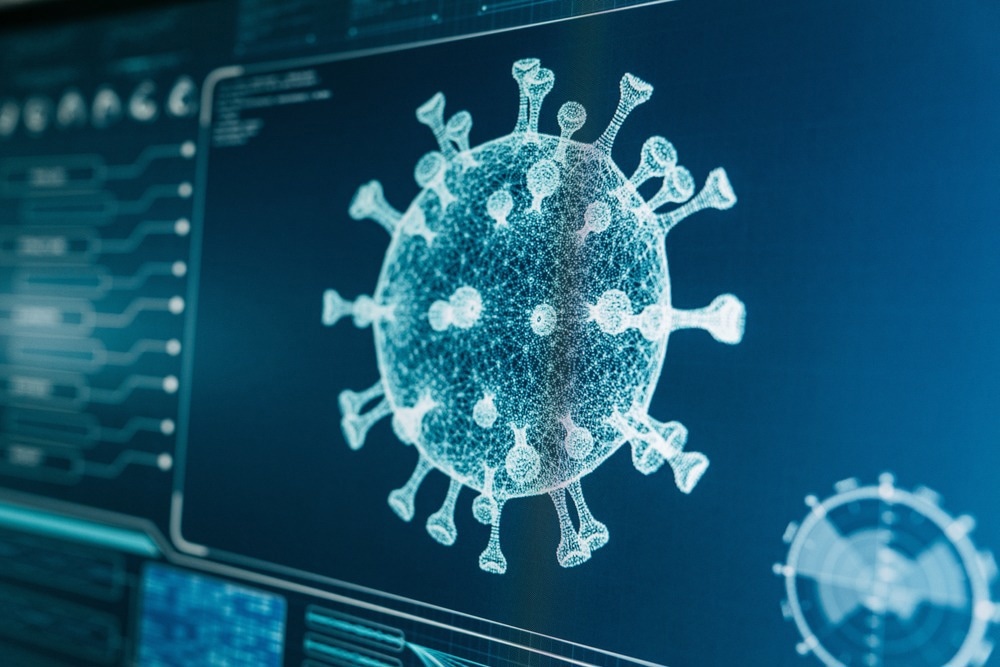A recent Talanta study examines the interaction between the severe acute respiratory syndrome coronavirus 2 (SARS-CoV-2) spike (S) glycoprotein through the use of a molecularly imprinted polypyrrole (MIP-Ppy) using Anson plot calculations.
The current study revealed that the MIP-Ppy modified electrode was more sensitive towards the SARS-CoV-2 S glycoprotein than the non-imprinted polypyrrole (NIP-Ppy) modified electrode. This affinity of the S protein can be utilized in the development of diagnostic sensor technologies for detecting SARS-CoV-2 infection.
 Study: Evaluation of the interaction between SARS-CoV-2 spike glycoproteins and the molecularly imprinted polypyrrole. Image Credit: Marcin Janiec / Shutterstock.com
Study: Evaluation of the interaction between SARS-CoV-2 spike glycoproteins and the molecularly imprinted polypyrrole. Image Credit: Marcin Janiec / Shutterstock.com
Background
Biosensors typically recognize analytes using bio-macromolecules, such as enzymes, antibodies, deoxyribonucleic acid (DNA), and aptamers. These bioanalytical systems are associated with several limitations, such as specific operating conditions and high production costs. This has led researchers to invest in developing artificial biorecognition systems based on synthetic receptors and molecularly imprinted polymers (MIPs) as potential alternative solutions.
Molecular imprinting refers to creating artificial receptors for specific target molecules on polymers or self-assembled materials. The analyte is usually targeted by natural receptors, thereby leading to electrochemical, optical, magnetic, and mass changes in the transducers.
Polypyrrole is widely used to design bioanalytical sensors. MIPs are made by polymerizing a monomer and cross-linker around a target molecule. Due to their thermal stability, reusability, and selectivity, MIPs are often used as recognition components in the designing of sensors.
To manufacture MIPs, monomers are polymerized in the presence of template molecules and then extracted, followed by the application of MIP-based structures to electrochemical MIP-based sensors.
A cavity corresponding to the template molecule is thus created in the polymer during polymerization. These cavities facilitate the recognition and binding of molecules on a targeted basis.
A key function of the SARS-CoV-2 S protein is recognizing and binding to cell receptors, allowing the virus to penetrate through cell membranes. Following the emergence of SARS-CoV-2, which is the etiological agent for the coronavirus disease 2019 (COVID-19), certain aspects of electrochemical approaches for identifying viral proteins using MIPs have been of interest.
The SARS-CoV-2 S, nucleocapsid, envelope, and membrane proteins may serve as template macromolecules in the production of MIPs. In the current study, MIP-Ppy was developed and applied to determine the SARS-CoV-2 S glycoprotein.
About the study
A working platinum electrode was electrochemically deposited with two types of polypyrrole layers, namely MIP-Ppy and NIP-Ppy. The performance of electrodes modified by MIP-Ppy and NIP-Ppy layers was evaluated by pulsed amperometric detection (PAD).
During the evaluation of PAD measurements, the integrated Cottrell equation-Anson plot, was used to calculate the amount of charge flowing through the MIP-Ppy and NIP-Ppy layers.
Study findings
When MIP-Ppy and NIP-Ppy modified electrodes were incubated in phosphate-buffered saline (PBS) containing the SARS-CoV-S spike glycoprotein, a significant reduction in current was observed. Based on the total charge versus the square of time charts, as demonstrated on the Anson plots, the interaction between the SARS CoV-2 S glycoproteins and MIP-Ppy was evaluated.
When assessing the relationship between the resultant slope values of the Anson plot and the glycoprotein concentration, it was concluded that MIP-Ppy adsorbs viral glycoproteins more strongly than NIP-Ppy. Of note, the Anson plot analysis showed that the SARS-CoV-2 S glycoprotein molecule interacts with MIP-Ppy and is partially adsorbed on NIP-Ppy. Thus, assessing the interaction between SARS-CoV-2 spike glycoproteins and MIP-Ppy can be successfully achieved using the Anson plots.
Additionally, the calibration curve of current values for the glycoprotein concentrations range from zero to 25 µg/mL was presented. These results depicted an exponential decrease in the calibration plot of the outlined system.
A significant difference was observed between the MIP-Ppy- and NIP-Ppy-modified electrodes for the amount of current dropped. More specifically, the MIP-Ppy-modified electrode exhibited greater sensitivity to the SARS-CoV-2 S glycoprotein as compared to the NIP-Ppy-modified electrode.
The calibration curve indicated that the current value measured for the MIP-Ppy modified electrode was 1.36 times higher than that of the NIP-Ppy modified electrode at an initial glycoprotein concentration of 0 µg/mL.
In addition, a complementary cavity was indented in the Ppy after the extraction of the SARS-CoV-2 S glycoprotein from MIP-Ppy. Taken together, the study findings indicate that this property can be utilized for developing a SARS-CoV-2 infection-detecting sensor.
Journal reference:
- Ratautaite, V., Boguzaite, R., Brazys, E., et al. (2022). Evaluation of the interaction between SARS-CoV-2 spike glycoproteins and the molecularly imprinted polypyrrole. Talanta. doi:10.1016/j.talanta.2022.123981